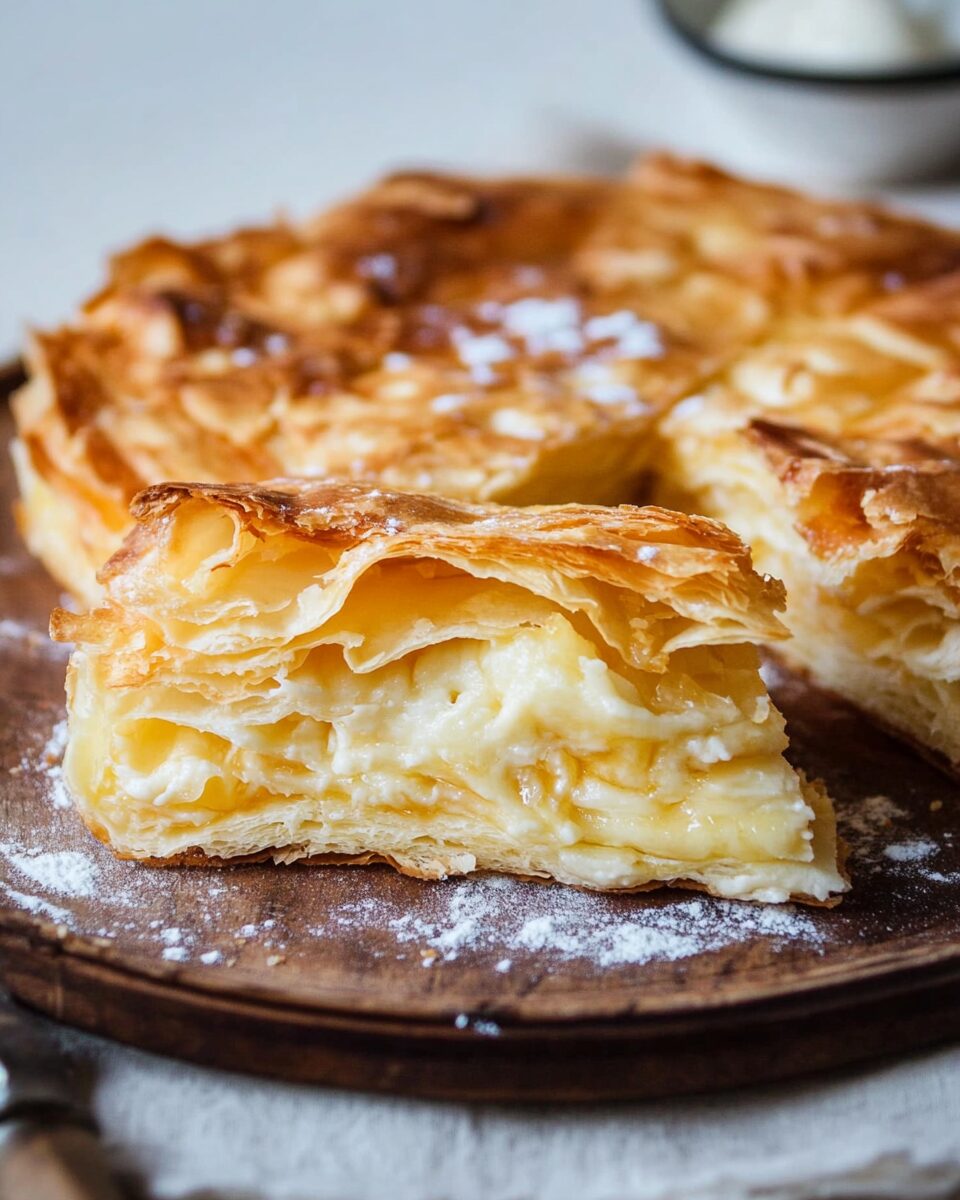Banitsa is a beloved Bulgarian pastry, known for its crisp, golden layers of phyllo dough filled with a rich and savory mixture of feta cheese, yogurt, and eggs. Baked to perfection, each bite delivers a delicious contrast between the flaky crust and the creamy filling. It’s a staple in Bulgarian households, enjoyed for breakfast, brunch, or even as a comforting snack.
This traditional dish is deeply rooted in Balkan culture, often prepared for festive occasions and family gatherings. Whether served warm with a dollop of yogurt or paired with a refreshing glass of ayran, Banitsa offers a unique taste experience that’s both satisfying and nostalgic. If you’ve never tried this crispy, cheesy delight, now’s the time to bring a piece of Bulgaria to your kitchen!
Full Recipe
Ingredients:
- 10 sheets of phyllo dough
- 2 cups feta cheese, crumbled
- 3 eggs
- 1 cup plain yogurt
- ½ cup sparkling water
- ¼ cup unsalted butter, melted
- 1 tablespoon olive oil
- ½ teaspoon baking soda
Directions:
- Preheat oven to 375°F (190°C) and grease a baking dish with olive oil.
- In a mixing bowl, whisk together eggs, yogurt, and baking soda.
- Add the crumbled feta cheese to the mixture and stir well.
- Lay one sheet of phyllo dough in the baking dish, brushing it with melted butter. Repeat with four more sheets.
- Spread half of the cheese mixture evenly over the phyllo layers.
- Continue layering and brushing with butter, adding five more phyllo sheets.
- Pour the sparkling water over the banitsa to enhance fluffiness.
- Bake for 35–40 minutes or until golden brown.
- Let cool for 10 minutes before slicing and serving.
Prep Time: 10 minutes | Cooking Time: 40 minutes | Total Time: 50 minutes
Kcal: 280 kcal | Servings: 6 servings
What is Banitsa?
Banitsa (also spelled banica or banitza) is a traditional Bulgarian pastry dish made from layers of thin phyllo dough filled with a savory mixture of eggs, yogurt, and cheese—usually the iconic tangy Bulgarian feta known as sirene. This dish is a cornerstone of Bulgarian cuisine and is as versatile as it is delicious. From everyday breakfasts to festive holiday meals, Banitsa holds a treasured place on the Bulgarian table.
The preparation of Banitsa is a hands-on process that reflects both simplicity and artistry. The magic lies in the perfect layering of phyllo dough and the rich, tangy cheese mixture that bakes into a golden, crispy masterpiece. Though it’s often enjoyed as a breakfast pastry, Banitsa can be served at any time of the day and is perfect warm or cold.
A Deeply Rooted Culinary Tradition
Banitsa has existed for centuries and is deeply embedded in Bulgarian culinary heritage. It’s more than just a savory pastry—it’s a cultural symbol. In many households, the making of Banitsa is a communal experience, passed down through generations of home cooks, often with family secrets and small personalized touches that make each Banitsa unique.
Traditionally, it’s served during major holidays and celebrations. On New Year’s Eve, Bulgarians prepare a special version of Banitsa with lucky charms or written wishes rolled into the layers. These fortunes—called kʼsmeti—range from health and love to wealth and travel, making Banitsa not only a delicious bite but also a fun, symbolic part of the holiday tradition.
Cultural Significance in Bulgaria
In Bulgarian culture, Banitsa is more than food—it’s comfort, tradition, and family. It’s often the first dish that Bulgarians living abroad crave when thinking of home. As a national staple, it represents warmth and familiarity. It’s also a dish that carries strong associations with maternal care, as grandmothers and mothers often bake Banitsa for their families as a symbol of love and nurturing.
Many Bulgarians also believe that no holiday breakfast is complete without Banitsa. Whether it’s Christmas morning, a wedding, or a birthday, a beautifully golden and flaky Banitsa on the table is almost mandatory. It’s paired with a warm cup of yogurt drink, boza, or sometimes just plain yogurt—making it filling and nourishing.
Different Variations of Banitsa
While the classic Banitsa contains a mixture of eggs, cheese, and yogurt, countless variations exist across regions and even between families. Some use milk instead of yogurt. Others add a touch of baking soda to make the filling fluffier and lighter. These small changes can create entirely different textures and flavors.
There are also versions with added ingredients like spinach (spanachena banitsa), pumpkin (tikvenik), leeks, or even minced meat. Sweet versions also exist—like the cinnamon-sugar tikvenik made with pumpkin and walnuts. These variants show how versatile and customizable Banitsa can be, adapting to seasonal ingredients or personal preferences.
One popular alternative is the spiral-shaped Banitsa, where the phyllo is rolled with filling and coiled into a snail shape before baking. This version, known as vitá banitsa, is often seen in bakeries and is particularly eye-catching.
Tips for the Perfect Banitsa
Achieving the perfect Banitsa takes some practice, but a few key tips can elevate your pastry from good to unforgettable:
- Use good quality phyllo dough: Thin and crisp sheets are key for achieving the perfect flaky texture. Handle with care so they don’t tear during layering.
- Crumble the cheese well: Bulgarian sirene cheese can be quite salty and crumbly, which helps distribute flavor evenly. If you can’t find sirene, a mix of feta and cottage cheese or cream cheese works well.
- Layer generously: Don’t skimp on butter or the filling between layers. Generous brushing ensures a rich, flaky finish.
- Use sparkling water or soda water: Pouring a bit of bubbly water over the assembled Banitsa before baking makes it even fluffier and helps puff the layers without weighing them down.
- Bake until golden brown: The aroma of a perfectly baked Banitsa is unmistakable, and the crispy top is one of its best parts. Keep an eye on your oven to avoid over-baking.
Serving Suggestions
Banitsa is traditionally served warm, straight from the oven, often accompanied by a drink like yogurt, ayran (a salted yogurt beverage), or boza (a sweet fermented grain drink popular in the Balkans). It’s commonly enjoyed for breakfast, but its versatility makes it suitable for lunch, brunch, or even a late-night snack.
You can serve it with a dollop of plain yogurt on the side or a fresh salad to balance the richness. For festive occasions, Banitsa is often presented as a centerpiece dish, garnished with fresh herbs or cracked black pepper for extra aroma.
The pastry is typically cut into squares or wedges and served in a family-style setting. Because it’s easy to transport, Banitsa is also a popular item for picnics and outdoor gatherings.
Is Banitsa Vegetarian?
Yes, the traditional version of Banitsa is vegetarian, containing no meat. Its core ingredients are eggs, dairy products, and phyllo dough. However, always check your phyllo packaging if you’re serving strict vegetarians, as some brands may include additives or non-vegetarian ingredients.
For vegans, Banitsa can be adapted by using plant-based yogurt, vegan butter, and tofu or cashew cheese in place of the eggs and feta. While the texture and flavor will differ, it can still be a satisfying and creative alternative.
Storing and Reheating
Banitsa stores well and can be refrigerated for up to 4–5 days. Simply wrap it in foil or place it in an airtight container. When you’re ready to enjoy it again, reheat it in a preheated oven at 300°F (150°C) for about 10–15 minutes. This helps restore its crispness, unlike the microwave, which can make it soggy.
It’s also freezer-friendly. Freeze in individual slices wrapped in parchment and foil for a quick breakfast or snack. Just reheat from frozen in the oven for the best results.
Why You Should Try Making Banitsa at Home
Making Banitsa at home connects you to a rich culinary tradition and brings a piece of Bulgarian culture into your kitchen. It’s a rewarding and sensory experience—from the crackle of the phyllo dough to the savory scent filling your home as it bakes.
Homemade Banitsa also allows for creativity and customization. You can tweak the filling, try different shapes, or experiment with savory and sweet versions. Plus, once you master the technique, it becomes a go-to dish for guests, family brunches, or quiet mornings.
Even if you’re new to working with phyllo dough, don’t be intimidated. This recipe is forgiving and adaptable, and even an imperfect Banitsa will still taste amazing. It’s the kind of dish that improves the more you make it and is always worth the effort.
Conclusion
Banitsa is more than just a pastry—it’s a culinary treasure with centuries of tradition behind it. Crisp on the outside, creamy on the inside, and bursting with rich, cheesy flavor, this savory Bulgarian pie is a joy to make and eat. Whether you’re exploring international flavors or reconnecting with your roots, Banitsa is a beautiful representation of comfort food with cultural depth.
This dish invites you to slow down, enjoy the process, and savor every bite. So why not bring a taste of Bulgaria into your home? Whether you stick to the classic or venture into creative variations, Banitsa promises to win over your heart—and your taste buds.






